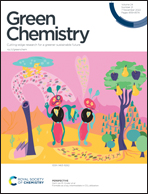A divergent photocatalysis strategy for selective aerobic oxidation of C(sp3)–H bonds promoted by disulfides†
Abstract
The selective oxidation of C(sp3)–H bonds is of uncontested utility in organic synthesis. Here, we report a novel and sustainable divergent protocol using O2 as a green oxidant enabled by disulfide in batch and flow reactions. In particular, by simply adjusting the wavelength of the light source, the chemoselectivity of amine oxygenation can be significantly switched from oxidative homo-coupling to oxidative deamination without a concomitant loss in photocatalytic activity. Furthermore, a wide range of aromatic hydrocarbons participates in the reaction with high efficiency, offering a sustainable alternative for the late-stage oxidative functionalization of benzylic C–H bonds. Mechanistic investigations revealed that the disulfide served as an excellent photoinitiator. The key C(sp3)–H bond activation step is believed to proceed via hydrogen atom abstraction affected by a benzothiazole-substituted thiyl radical for further oxidation processes. The reaction can be significantly improved in a microflow reactor, enabling the safe use of oxygen and enhanced irradiation of the reaction mixture. We anticipate that a broad scope with wide functional group compatibility, operational simplicity, and scalability in a flow reaction would bring useful and practical applications of this catalysis strategy to various fields.



 Please wait while we load your content...
Please wait while we load your content...